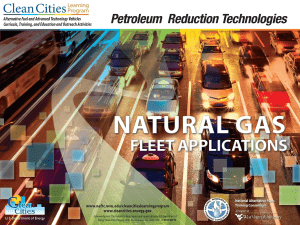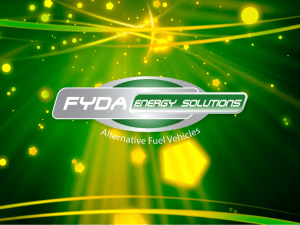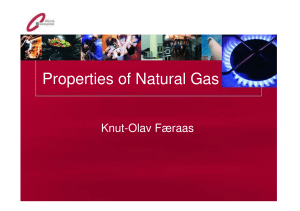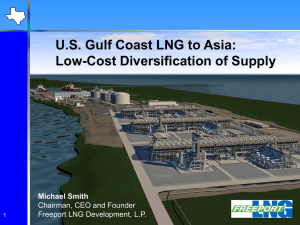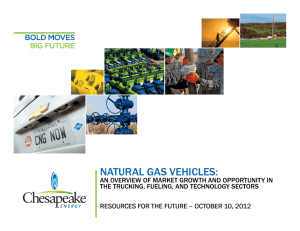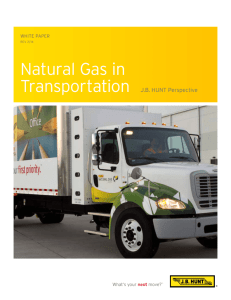Paul Chimbodza Oil and gas Beneficiation
advertisement
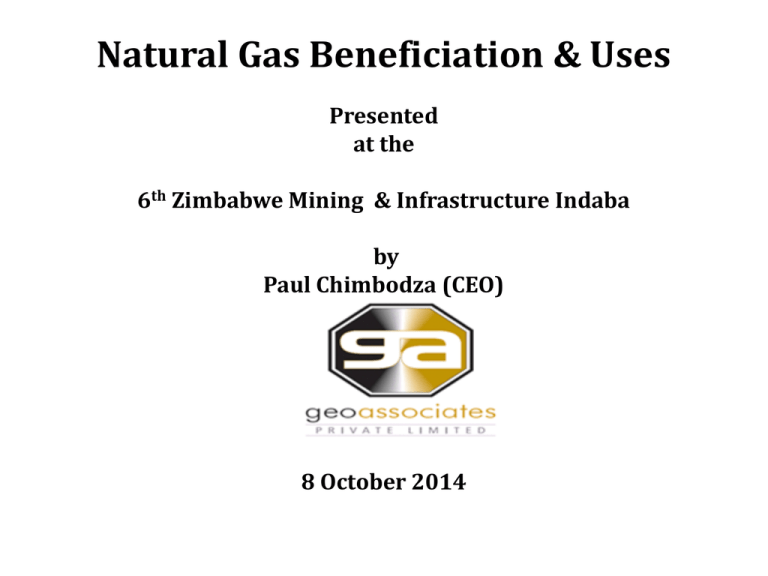
Natural Gas Beneficiation & Uses
Presented
at the
6th Zimbabwe Mining & Infrastructure Indaba
by
Paul Chimbodza (CEO)
8 October 2014
What is Natural Gas?
•
Natural gas is a fossil fuel formed when layers of buried plants, gases, and animals
are exposed to intense heat and pressure over millions of years. The energy that the
plants originally obtained from the sun is stored in the form of chemical bonds in
natural gas.
•
Natural gas is a hydrocarbon gas mixture consisting primarily of methane, but
commonly includes varying amounts of other higher alkanes and even a lesser
percentage of carbon dioxide, nitrogen, and hydrogen sulfide.
•
Natural gas is an energy source often used for heating, cooking, and electricity
generation. It is also used as fuel for vehicles and as a chemical feedstock in the
manufacture of plastics and other commercially important organic chemicals.
(Wilkepedia)
Typical composition of Natural Gas
• Methane
CH4
• Ethane
C2H 6
• Propane
C3H 8
• Butane
C4H10
• Carbon Dioxide
CO2
0 - 8%
• Oxygen
O2
0 - 0.2%
• Nitrogen
N2
0 - 5%
• Hydrogen Sulphide
H 2S
0 - 5%
• Rare gases
A, He, Ne, Xe
70-90%
0 - 20%
trace
Schematic of Oil and Gas geology
Natural Gas Global Reserves
(as of 2010)
World natural gas supply and demand
Source: BP 2006 Annual Statistic Review
Reserves
Consumption Reserves/Prod.
(Tcf)
(Tcf/Yr)
(Yrs)
North America (ex Arctic)
263
27.3
10
Europe
201
18.5
11
Asia Pacific
524
14.4
36
S & C America
248
4.4
56
Former Soviet Union
2059
21.1
98
Africa
508
2.5
203
Middle East
2546
8.9
286
Total
6348
97.1
65
Natural Gas Nomenclature
•
•
•
•
Hydrocarbons - Coal, Oil, Gas, CBM, shale gas
LPG
Liquefied Petroleum Gas
LNG
Liquid Natural Gas
CNG
Compressed Natural Gas
Natural Gas processing
Uses of Natural Gas
• 22% of energy in the USA is gas powered
• Electricity generation
• Manufacturing sector
• Fertiliser
• Residential use
• Motor vehicles
• Substitute for diesel and coal powered plants
Natural Gas footprint
Natural Gas footprint
Markets and Infrastructure
•
Zimbabwe sedimentary basins proximal to existing and future pipeline
infrastructure for the domestic and export markets
•
Numerous regional markets exist to monetise oil and gas in a starved market
•
Southern Africa power crisis affecting growth in the region amidst a huge push to
adopt gas as an alternate energy source to coal
POTENTIAL GAS MARKETS
•
Hwange power station
•
Pande-Temane gas pipeline to
Rovuma Basin
gas discoveries
South Africa
•
Feruka and Harare refineries
•
Sable Chem ammonia plant
•
Rovuma basin LNG plants
•
IPP exports to any country
within Southern Africa through
the SAPP
Pande/Temane
gas fields
Electricity Power generation
Discovery of a commercial natural gas resource
will provide Zimbabwe with a means to
generate base load power supply at
substantially shorter lead times and cost
compared to coal-fired generation plants.
Natural gas continues to be the fuel of choice in
many regions of the world in the electric power and
industrial sectors due to its significant price discount
relative to oil and its lower carbon intensity
compared to coal. The development of natural gas
resources from shale gas and other sources in the
United States over the past few years has seen
significant reduction of energy prices which has
increased industrial competitiveness substantially.
Natural gas and the energy mix matrix
Fertiliser Production
• Natural gas is a major feedstock for the production of ammonia, via the
Haber process, for use in fertilizer production.
• Natural gas is first cleaned from sulfur, and then mixed with heated
water vapor and supplied to the reactor, where it passes through
catalyst beds. This stage is called primary reforming or gas-vapor
conversion. A gas mixture composed of hydrogen, methane, carbon
dioxide (СО2), and carbon oxide (СО) exits from the reactor.
• Then, this mixture is sent to secondary reforming (gas-vapor
conversion), where it is mixed with atmospheric oxygen, vapor, and
nitrogen in proper proportions. At the next stage, CO and CO2 are
removed from the mixture. Then, a mixture of hydrogen and nitrogen is
sent to ammonia synthesis.
• Ammonia as such is a fertilizer; it is also used as a coolant in
refrigerating units and as a feedstock for production of nitrogen
compounds, such as nitric acid, ammonia nitrate, and carbamide.
Domestic Household Use
• Natural gas fired stoves can generate temperatures in
excess of 1100 °C (2000 °F)
• Independent reticulation piping to supply homes,
where it is used for many purposes including stoves,
ovens, geysers, dryers, central heating and cooling .
• Compressed natural gas (CNG) is used in homes
without connections to piped-in public utility
services, or with portable grills.
• However, as CNG costs more than LPG, LPG (propane)
is the dominant source of home gas.
Boilers
Gas to Liquids (GTL)
• Liquid fuels can also be produced from natural gas using the
gas-to-liquid technology (GTL).
• Liquid hydrocarbons were first produced from synthesis gas by
German chemists Franz Fischer and Hans Tropsch in 1923.
• They used coal as a source of hydrogen at that time, though.
Currently, different versions of the Fischer-Tropsch method
are applied in many marketed processes for conversion of gas
into liquid hydrocarbons.
• Since natural gas is a quite inert product, it is first virtually
always converted into a more reactive gas-vapor mixture, the socalled synthesis gas (mixture of CO and Н2).
• Gas to Liquid products include, synthetic oil, diesel fuel, as
well as lubricants and paraffins.
LNG (Liquefied Natural Gas)
•
Natural gas deposits are usually found in remote areas from end-users and there is
need for transportation either by natural gas piping or by LNG vessels
•
Liquefied natural gas, or LNG, is natural gas that has been supercooled to
-162 degrees Celsius and condenses into a liquid. When in liquid form, natural
gas takes up to 600 times less space than in its gaseous state, which makes it
feasible to transport over long distances.
•
For natural gas to be liquefied all impurities must be removed such as:
- Sulfur, carbon dioxide and mercury which are corrosive to LNG equipment
- Water, which could freeze and cause equipment blockage
- Heavier hydrocarbons which could also freeze like water
•
LNG is odorless, colorless, non-corrosive and non-toxic. Its weight is less than onehalf that of water
•
LNG is not stored under pressure. If the tank is ruptured, there is no massive
release of energy and thus no explosion.
•
For an explosion to occur, LNG must first return to its gaseous state and then the
natural gas vapors must accumulate in a confined space in a perfect mixture of 5 to
15 percent of gas in air, and encounter an ignition source.
LNG –Regasification
- Liquefied natural gas (LNG) offloaded from the ship
- moving it into cold storage tanks and then regasifying it back into natural gas to send to market.
- The grey lines represent natural gas, and the yellow lines represent LNG
- LNG losses due contact with warmer air in the top of the ship containers and in the LNG storage tanks.
- This natural gas is siphoned out of the tanks and moved into the pipeline
LNG Value chain
( $7 to $14 billion dollars of investment from start to finish)
LPG (Liquefied Petroleum Gas)
•
Liquefied petroleum gas or liquid petroleum gas (LPG or LP gas), also referred
to as simply propane (C3H8), or butane(C4H10) , is a flammable mixture of
hydrocarbon gases used as a fuel in heating appliances, cooking equipment, and
vehicles.
•
LPG is composed primarily of propane and butane, while natural gas is composed
of the lighter methane and ethane
•
LPG is prepared by refining petroleum or "wet" natural gas,
•
It was first produced in 1910 by Dr. Walter Snelling, and the first commercial
products appeared in 1912. It currently provides about 3% of all energy consumed
•
Burns relatively cleanly with no soot and very few sulfur emissions.
•
Calorific value of 46.1 MJ/kg compared with 42.5 MJ/kg for
fuel oil-and 43.5 MJ/kg for premium grade petrol (gasoline).
•
LPG boiling point is below room temperature & will evaporate
quickly at normal temperatures and pressures
•
Stored in high pressure cylinders of varied sizes.
CNG – Compressed Natural Gas
• Compressed Natural Gas (CNG) is Methane gas stored at high
pressure and can be used in place of gasoline (petrol), Diesel fuel and
propane/LPG.
• CNG combustion produces fewer undesirable gases than the fuels
mentioned above.
• CNG is made by compressing natural gas (which is mainly composed of
methane, CH4), to less than 1 percent of the volume it occupies at
standard atmospheric pressure.
• Used in traditional gasoline/internal combustion engine vehicles that
have been modified or in vehicles which were manufactured for CNG
use, either alone ('dedicated'), with a segregated gasoline system to
extend range (dual fuel) or in conjunction with another fuel such as
diesel (bi-fuel).
CNG for Natural Gas Vehicles
•
Compressed Natural Gas as a vehicle fuel is much cheaper and environmentally
cleaner than petroleum products.
• CNG is a cleaner alternative to other automobile fuels such as gasoline (petrol)
and diesel.
• Compressed (or pressurized) methane costs half as much as petrol with the
octane number of 76; extends the service life of engine; and can improve the
urban ecology
• By the end of 2012 there were 17.25 million natural gas vehicles worldwide,
led by Iran (3.3 million), Pakistan (3.1 million), Argentina (2.18 million), Brazil
(1.73 million), India (1.5 million), and China (1.5 million).
Global CNG uptake for NGV
LNG in Aviation
• Russian aircraft manufacturer Tupolev is currently running a
development program to produce LNG- and hydrogen-powered
aircraft.The program has been running since the mid-1970s, and
seeks to develop LNG and hydrogen variants of the Tu-204 and Tu334 passenger aircraft, and also the Tu-330 cargo aircraft.
• It claims that at current market prices, an LNG-powered aircraft
would cost 5,000 roubles (~ $218/ £112) less to operate per ton,
roughly equivalent to 60 per cent, with considerable reductions to
carbon monoxide, hydrocarbon and nitrogen oxide emissions.
• The advantages of liquid methane as a jet engine fuel are that it has
more specific energy than the standard kerosene mixes do and that
its low temperature can help cool the air which the engine
compresses for greater volumetric efficiency, in effect replacing an
intercooler. Alternatively, it can be used to lower the temperature of
the exhaust.
Paint, Glue and Vinegar
• Methanol (CH3OH) is produced from natural
gas under a scheme similar to the FischerTropsch process. It is used as an agent for
preventing hydrate plugs that are formed in
pipelines at low temperatures. Methanol can
also become a feedstock for manufacturing
more complex chemical substances:
formaldehyde, insulation materials,
varnishes, paints, glues, fuel additives, and
acetic acid.
Natural Gas prices in US dollars per million BTUs
($/mmbtu).
(Henry Hub)
mmbtu = 293kwh = US$29 equivalent (@10c/kwh)
Conquering the new Zimbabwean hydrocarbons frontier
is going to need collective effort by all players
Thank you.
May your GOD bless you abundantly
now and beyond
